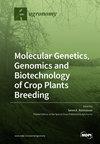Detection of Soybean Insect Pest and a Forecasting Platform Using Deep Learning with Unmanned Ground Vehicles
IF 3.4
2区 农林科学
Q1 AGRONOMY
引用次数: 3
Abstract
Soybeans (Glycine max (L.) Merr.), a popular food resource worldwide, have various uses throughout the industry, from everyday foods and health functional foods to cosmetics. Soybeans are vulnerable to pests such as stink bugs, beetles, mites, and moths, which reduce yields. Riptortus pedestris (R. pedestris) has been reported to cause damage to pods and leaves throughout the soybean growing season. In this study, an experiment was conducted to detect R. pedestris according to three different environmental conditions (pod filling stage, maturity stage, artificial cage) by developing a surveillance platform based on an unmanned ground vehicle (UGV) GoPro CAM. Deep learning technology (MRCNN, YOLOv3, Detectron2)-based models used in this experiment can be quickly challenged (i.e., built with lightweight parameter) immediately through a web application. The image dataset was distributed by random selection for training, validation, and testing and then preprocessed by labeling the image for annotation. The deep learning model localized and classified the R. pedestris individuals through a bounding box and masking in the image data. The model achieved high performances, at 0.952, 0.716, and 0.873, respectively, represented through the calculated means of average precision (mAP) value. The manufactured model will enable the identification of R. pedestris in the field and can be an effective tool for insect forecasting in the early stage of pest outbreaks in crop production.基于无人地面车辆的大豆害虫检测与深度学习预测平台
大豆(Glycine max(L.)Merr.),作为全球流行的食品资源,从日常食品、保健食品到化妆品,在整个行业都有各种用途。大豆很容易受到害虫的侵害,如蝽、甲虫、螨虫和飞蛾,从而降低产量。据报道,在整个大豆生长季节,足背陆龟(R.pedetris)会对豆荚和叶片造成损害。在本研究中,通过开发一个基于无人地面车辆GoPro CAM的监测平台,根据三种不同的环境条件(豆荚填充阶段、成熟阶段、人工笼)进行了检测R.pedetris的实验。本实验中使用的基于深度学习技术(MRNN、YOLOv3、Detectron2)的模型可以通过web应用程序立即受到挑战(即,使用轻量级参数构建)。通过随机选择对图像数据集进行分布以进行训练、验证和测试,然后通过标记图像进行预处理以进行注释。深度学习模型通过图像数据中的边界框和掩模对R.pedetris个体进行定位和分类。该模型实现了高性能,分别为0.952、0.716和0.873,通过计算的平均精度(mAP)值表示。所制造的模型将能够在田间识别R.pedetris,并可以成为作物生产中害虫爆发早期昆虫预测的有效工具。
本文章由计算机程序翻译,如有差异,请以英文原文为准。
求助全文
约1分钟内获得全文
求助全文
来源期刊

Agronomy-Basel
Agricultural and Biological Sciences-Agronomy and Crop Science
CiteScore
6.20
自引率
13.50%
发文量
2665
审稿时长
20.32 days
期刊介绍:
Agronomy (ISSN 2073-4395) is an international and cross-disciplinary scholarly journal on agronomy and agroecology. It publishes reviews, regular research papers, communications and short notes, and there is no restriction on the length of the papers. Our aim is to encourage scientists to publish their experimental and theoretical research in as much detail as possible. Full experimental and/or methodical details must be provided for research articles.
 求助内容:
求助内容: 应助结果提醒方式:
应助结果提醒方式:


